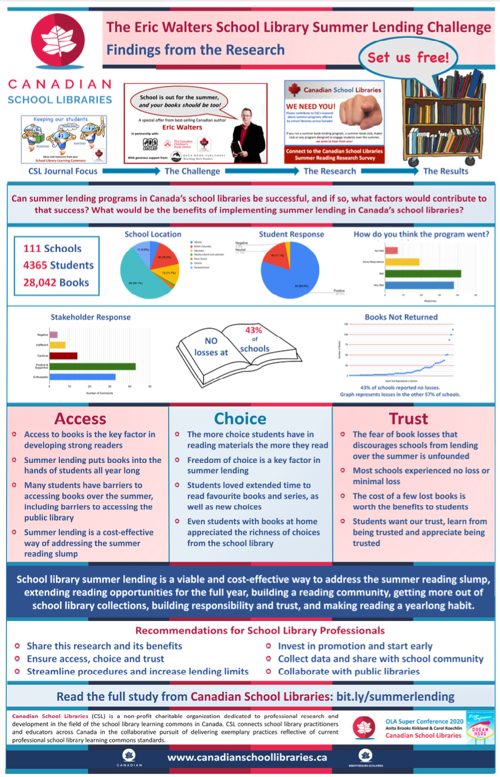
Are You Ready to Set Your Books Free?
By Anita Brooks Kirkland & Carol Koechlin
Editors’ Note: With uncertainty about the remainder of the school year, the summer lending project has been postponed until next year. However, should schools re-open before the summer vacation, we strongly encourage all schools to facilitate summer lending. Be sure to check the CSL website for updates. Please read on to take inspiration from the success of the 2019 challenge!
Summer in Canada. For elementary and secondary students across the country, an idyllic two months’ vacation from school to enjoy the fleeting warm weather, all manner of outdoor activities, family vacations, and a chance for leisurely reading. For many children the summer is full of opportunity, stimulation, and growth. However, a body of research indicates that for many children who do not have access to books and reading, the summer may leave them ill-prepared for the new school year. Even the most avid readers may find it challenging to find enough choice in reading materials to keep them engaged over the summer.
School libraries in Canada have collections developed particularly to engage young readers, yet Canada’s elementary and secondary students have no access to these resources over the summer. To many, including the editors of the Canadian School Libraries Journal, this made little sense.
For two successive years the CSL Journal published accounts of successful initiatives to support summer reading and promoted the idea with our tag line, Keep them reading, thinking and making. “Is there more we can do from the library learning commons to get more books into the hands of students and also spur them to keep on learning over the summer break?” was the question put out to readers across Canada.
The Summer Lending Challenge is Born
In the spring of 2019 best-selling Canadian author Eric Walters got involved with his CSL Journal article, School Is Out for the Summer and Your Books Should Be, Too. He put out a challenge to schools across Canada to get books in their libraries out over the summer, into the hands of the students who wanted and needed to read. Walters’ call provided a wonderful opportunity for Canadian School Libraries to investigate whether summer lending programs in Canada’s school libraries could be successful, and if so, what factors would contribute to that success.
Reaction to the article on social media was huge, and before we knew it, over 150 schools had signed up. Walters sought and received endorsement from Canadian Children’s Book Centre (CCBC) and the Canadian Society of Children’s Authors, Illustrators and Performers (CANSCAIP) and both organizations actively promoted the idea via their own channels. He also received generous support from Orca Book Publishers, who agreed to provide program incentives. And so the Eric Walters Summer Lending Challenge was born.
Findings from the Research
Through a detailed survey, the researchers sought to answer the questions:
Can summer lending programs in Canada’s school libraries be successful, and if so, what factors would contribute to that success?
What would be the benefits of implementing summer lending in Canada’s school libraries?
Over 80% of respondents in our survey reported very positive results with summer lending through the school library learning commons. The benefits of summer reading were consistent with existing research, but also revealed some unique outcomes. While the literature does recount involvement of school libraries in some successful summer reading programs, the potential of this simple model of summer lending from school libraries had not been fully explored.
Our study provides substantial evidence that summer lending programs have a positive impact on students. One might expect that students would appreciate the opportunity to borrow books from the school library over the summer but we were pleasantly surprised by the depth of student responses.
Respondents reported on student engagement in reading, appreciation of choice and time to read books without constraints as well as gratitude for the opportunity to borrow the books for the summer and for the trust granted to them to be responsible and return books in September. These findings were replicated many times in various schools. Positive responses were noted by those leading the summer reading programs as well as by many teachers, parents and administrators.
Factors Contributing to Success
Specific themes emerged as we analyzed the survey responses.
Access: A summer lending program initiated by the professionals in the school library learning commons has proven to contribute to participation and positive results. Our research indicates that simply lending books from the existing collection will reap positive results and make good use of excellent resources without further investment. Loss of books is minimal and considerably less expensive than purchasing a few books for students to own, as is typically done in many summer reading programs. Even students with books at home appreciated having increased access. Public libraries are an important point of access, but many students remarked that they had limited access to the public library over the summer because of the challenges of just getting there. Access to books children want to read is key and the school library is a natural and inexpensive solution that is already in place.
Choice: Over and over again in the literature review previous researchers proclaimed the importance of giving students choice of personal reading materials to ensure summer reading engagement. This success factor was confirmed in our research by both students and other stakeholders. Students really appreciated the freedom to select books they wanted to read and the luxury of borrowing several books by their favourite authors or even a whole series. As expected, freedom of choice was an important factor in the success of summer lending from the school library learning commons. One special aspect to our study was the mention of having a professional on hand to guide student choices when needed.
Trust: Probably the biggest inhibitor for schools to try summer lending from the school library is the fear of book loss. Our study sheds new light on this roadblock. Responsible behaviours cannot grow without opportunity and trust. Our findings indicate that students were very appreciative of the trust they were granted to care for and return borrowed materials. This factor was repeated again and again in responses from both students and other stakeholders. This trust translated into student engagement in borrowing books, appreciation for the program, and following through with their responsibility to return books in September. The gains in building trusting relationships with students surely outweigh the minimal loss of books. This factor seems to be unique to our study and it is hoped this finding will put to rest the book loss syndrome for schools in the future.
The benefits of summer lending became clear through the research, and Canadian School Libraries can confidently make recommendations to school library professionals for continuing the success of and extending school library learning commons summer lending programs.
Benefits of implementing summer lending in Canada’s school libraries:
- Engaging students in reading to address the summer learning slump
- Building a community of readers within and across schools
- Putting books into the hands of students during the summer and all year
- Getting more out of school library collections
- Building responsibility and trust
- Making reading a yearlong habit
Realizing these benefits requires support from school administrators and teachers. Summer lending is a positive influence on placing the library learning commons at the heart of literacy and school-wide improvement.
Recommendations for school library professionals for continuing the success of and extending school library learning commons summer lending programs:
- Share this CSL summer reading research widely and discuss the potential positive impact for students in your school or school district.
- Ensure that access, choice and trust are key factors in designing your summer lending program.
- Discuss the impact that administrative procedures can have on determining the success of summer lending. Consider increasing lending limits and streamlining processes to facilitate student loans and to reduce losses.
- Invest in promotional activities to engage teachers, parents and students in participation.
- Collect school data, and analyze and share results with administration and your school community.
- Continue to build connections with local public libraries and collaborate on ways to engage more students in summer reading, including overcoming potential barriers to access.
Ideas to consider for extending programs to build a culture of summer reading:
- Utilize online collaboration spaces and technologies and social media for discussions and activities to get students reading, thinking and making.
- Investigate how the virtual school library learning commons can increase equitable access to quality reading materials.
- Reach out to reluctant readers and special needs learners throughout the school year and encourage them to continue connecting with books over the summer.
- Consider the needs of reluctant readers and special needs learners by providing access to appropriate texts and technologies.
Are You Ready for Summer 2020?
Plans are already underway for the second year of the Eric Walters Summer Lending Challenge. With his characteristic energy, Eric has already lined up many authors and illustrators to contribute to the package of program resources and incentives that each participating school will receive. CSL is looking at new opportunities to build on our first year of research. The goal for 2020 is to get 500 schools to sign up! Are you ready to set your books free?

